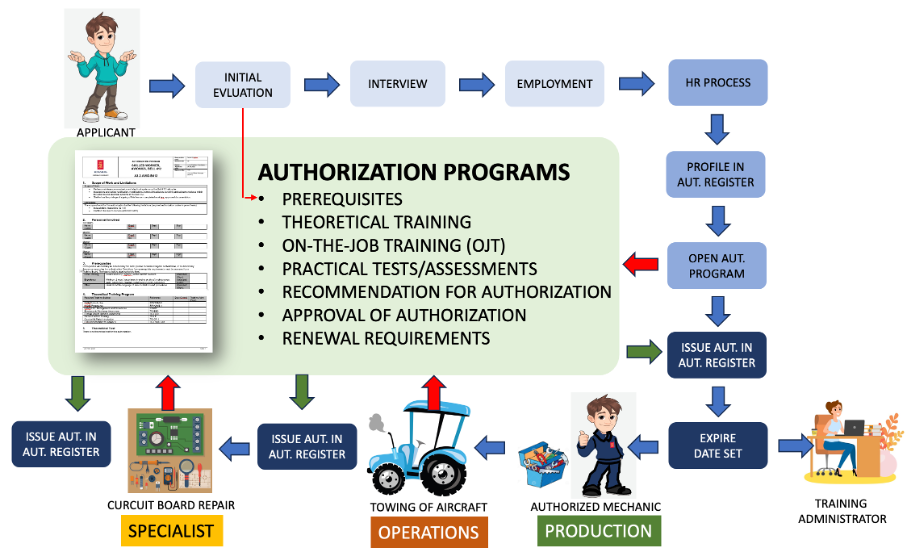The importance of competence management in complex organizations
Initial qualifications in aviation
The aviation industry must comply with a multitude of different rules and regulations requirements regarding control of the knowledge, skills and attitude of their production staff. These three key elements are essential for safe operation and maintenance of aircraft and together they are the definition of competence.
The aviation legislations are comprehensive and complex, often segregated in different settings, aircraft types, type of operation. The result is a lot of documents, systems and administrative work. Licenses, health certificates, courses etc. must be followed up for each employee individually. In addition to the requirements from the aviation authorities, you will need to handle general requirements for certificates from the authorities for operation of certain equipment such as forklifts, cranes and handling of dangerous goods. Personnel must also be qualified to handle and comply with airport security training and environmental issues.
In order to reduce costs it will be necessary to limit some of the work tasks that requires special training, continuous practice or special skills such as engine run-up or rigging of flight controls. To let everybody do everything is both expensive and a safety issue since some of the work tasks requires special training and are done rarely. Then, sufficient experience will be a problem since you don´t want to do unplanned maintenance tasks on “healthy” aircraft just for training purposes.
Authorizations
An authorization in aviation is a common used expression for an approval that the company issue to someone allowing them to perform a defined work task or position. In complex maintenance organization there may be several hundred types of different authorizations – in particular if the scope of work covers both line and base maintenance and includes different aircraft types, components or engine maintenance. A senior employee may need to possess 8-10 authorizations to perform day-to-day work.
All authorizations must have a qualification program defining the pre-requisites, training and assessment requirements an employee must successfully complete. The authorizations requirements must be easy to find, they must be acknowledged at the correct level, and should be standardized. References to certificates and courses must also be updated and valid, and most of them will need to be updated regularly.
When the employees completes the qualification programs, all issued authorizations and courses must be documented. Assessment and practice must be signed by persons holding the required privileges.
All this is challenging, and demands resources. A multitude of different systems and software solutions is in use, but if you don,t build your authorization structure smart, it will you a lot of extra resources.
Structure and Authorization Programs
Intrinsic have over 20 years’ experience in continuously building and improving a complete system for handling authorizations from the major airlines, the offshore helicopter industry and recently also the defense industry which is introducing a military variant of the EASA regulations (EMAR).
The fundamental idea is to build a system in different levels to minimize bureaucracy and time, and to build specialized authorizations based on other authorizations.
Each authorization has an approved qualification program, which we call “Authorization Program”. There is one approved Authorization Program for each single authorization. They are designed as a check list and will when completed give you the entire records you need for the authorization process.
The illustration below the article shows how an Authorization Program is a key element in the initial qualification process of a new employee – in this case becoming an authorized aircraft mechanic. The illustration also shows that other Authorization Programs will be initiated later in order to qualify the employee for other tasks such as operation of equipment of specialist task building on authorizations you already have.
The key word is to build up a system of authorizations to minimize admin costs, improve safety and making work planning much easier. Mapping competencies in an organization, structuring them and building a system is one of our key products within consultancy.
The Competency Register – CanDo
Most supervisors and managers in aviation have been fighting several times to find evidence for a person’s authorization during audits or authorization renewal processes. Follow up of expire dates and ensure that your maintenance staff is “legal” for the work they are doing is still demanding, even with a good structure or authorization system. And, when you are planning work for the weekend or you need to send a team somewhere to replace an engine, you need to know who can do what – Quickly!!
In 2020 we started building a software program that could handle an authorization system effectively and be available for all employees. We have called this software “CanDo”, and we like to describe it as a Competency Register.
CanDo User-End
CanDo is based on Intrinsic´s software platform Helix which has been used for many years by the IAP Assessment Tool. It is developed with focus on the users – production staff, supervisors, planners and management. Your production staff and management can use their smart phones or iPads to access CanDo User-End for finding “who can do what and where” easily. They can search for several criteria such as who has the authorization “Independent Inspector” at our bases base in Tromsø, or checking that someone on the team we are sending for engine replacement in Copenhagen have an authorization for operation of cranes. You can also find who employee number 12345 is, or where does the person Arne Danielsen work and what is his phone number?
Your employees and their superiors will get alert messages when an expire date is approaching – either as notifications on your smart phone or iPad when you log in – or by e-mails. They can also doubleclick on their authorizations and read the scope of work and its limitation. Here they will also see personal limitations (if they have one), and they can read the renewal requirements.
Read-and-sign documents
Sending out read-and-sign documentation such as bulletins, safety notices or engineering orders is also possible in CanDo. The administrator can send these documents in .pdf or .jpg format to groups of employees holding a certain authorization, working at a defined location or a group that you define your self.
This is a very easy way to send out mandatory reading documents since you don´t have to create address lists in outlook and remember to check that everybody has read and acknowledged. In addition, the employees will find all bulletins they have read previously in the library function of the user end.

